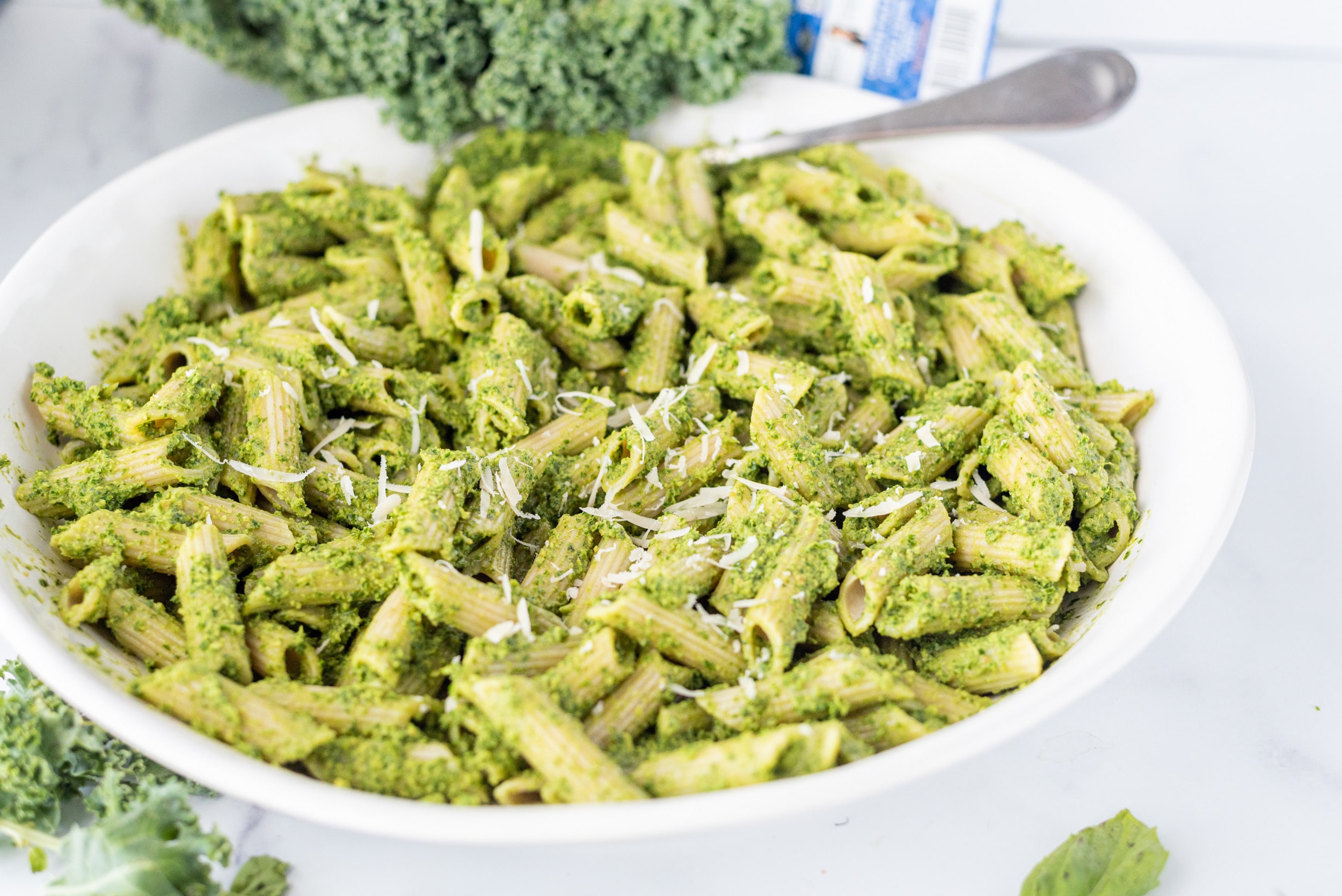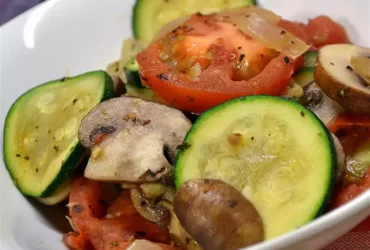Ingredients
Kale and Pesto Base
The heart of any great pasta dish lies in its sauce, and for a kale pesto recipe, the ingredients play a crucial role. Here are the essential components that will make your pesto base shine:
Base Greens
The star of our show is, of course, kale! Choose curly-leaf or lacinato (also known as Tuscan) kale for its tender leaves and robust flavor.
Cheese
Parmesan, specifically. This hard Italian cheese provides a salty, nutty depth to your pesto that complements the earthy sweetness of kale perfectly. Look for high-quality, aged Parmesan for the best results.
Herbs
Fresh basil is an absolute must in traditional pesto, adding a bright, herbaceous note to balance out the richness of the cheese and greens. You can use either sweet or Genovese basil – whichever suits your taste buds.
Nutrition plays a significant role when selecting ingredients for our kale pesto recipe. Here are some considerations:
Olive Oil
Choose a high-quality, cold-pressed olive oil that’s rich in antioxidants and has a low acidity level. This will help preserve the delicate flavor of your kale and ensure a smooth, creamy texture.
Garlic
Fresh, organic garlic is essential for adding depth to our pesto without overpowering the other ingredients. You can roast or sauté it lightly before blending for added sweetness.
To make your kale pesto recipe even more impressive, consider these additional tips:
Acidity Balance
Add a squeeze of fresh lemon juice to balance out the richness of the cheese and olive oil. This will also enhance the brightness of your herbs.
Nutty Depth
Introduce some toasted pine nuts or walnuts for added texture and a nutty flavor that complements the Parmesan and kale beautifully.
1 cup fresh kale leaves, stems removed and discarded
Kale pesto recipe often highlights the importance of selecting the freshest ingredients to bring out the best flavors and textures in the dish. When it comes to the kale leaves, choosing the right type is crucial for achieving the desired taste and consistency.
The recipe calls for 1 cup of fresh kale leaves, which implies that you will need a substantial amount of kale to create the pesto sauce. Fresh kale leaves are packed with nutrients and have a mild, slightly bitter flavor, making them an ideal choice for this recipe.
To prepare the kale, stems removed and discarded is a specific instruction that suggests removing the woody or tough parts of the kale plant. This ensures that only the tender and flavorful leaves are used in the recipe.
When selecting kale leaves, look for those with crisp, dark green color and no signs of wilting or discoloration. The leaves should be fresh and have a pleasant aroma, which will carry through to the finished pesto sauce.
The reason for using only the leaves and discarding the stems is that they can impart a slightly bitter taste and tough texture to the pesto sauce. By removing them, you ensure that your kale pesto has a smooth and creamy consistency, perfect for pasta dishes, salads, or as a dip.
1/4 cup pine nuts (or walnuts or almonds)
Pine nuts are a fundamental ingredient in traditional pesto sauce, particularly in Italian cuisine. They serve as a rich source of healthy fats and add an element of crunch to the final product. Pine nuts have a unique, buttery flavor that complements the basil leaves and garlic found in most pesto recipes.
In the context of this Kale Pesto Recipe, pine nuts are used alongside kale, garlic, lemon juice, olive oil, salt, and Parmesan cheese. The pine nuts undergo some processing before being incorporated into the sauce; they may be toasted lightly to enhance their flavor or blended raw in a food processor to create a smooth consistency.
Other options for the initial ingredient can include walnuts or almonds. Both of these alternatives will result in slightly different flavors, with the nutty taste of the walnuts or the subtle sweetness of the almonds adding character to the final product. When substituting pine nuts with either of these options, consider adjusting the amount used in accordance with personal preference, as some people may find the stronger flavor more desirable.
The proportions specified in this recipe – 1/4 cup pine nuts (or walnuts or almonds) – are a good starting point for creating the Kale Pesto sauce. Feel free to adjust these amounts based on your personal taste preferences and the specific ingredients you have available.
1/2 cup grated Parmesan cheese (you can also use other hard cheeses like Pecorino or Romano)
In a traditional Italian recipe, ingredients play a crucial role in defining the flavors and textures of the dish. For a classic Kale Pesto Recipe, you will need the following key components:
1/2 cup grated Parmesan cheese (you can also use other hard cheeses like Pecorino or Romano):
- This type of cheese is essential for adding depth and umami flavor to the pesto.
- Parmesan, in particular, has a sharp, salty taste that complements the bitterness of the kale perfectly.
- Other hard cheeses like Pecorino or Romano can also be used as alternatives, offering slightly different flavor profiles but still rich and savory.
The key characteristics of these cheeses are their ability to melt slowly, creating a smooth texture when combined with the other ingredients in the pesto. The sharpness of the cheese also helps balance the bitterness of the kale, preventing it from becoming overpowering.
Oil and Seasonings
In the realm of cooking, ingredients play a vital role in bringing flavors together to create a harmonious dish. When it comes to the Kale Pesto Recipe, several key ingredients come into play.
The first and most crucial ingredient is kale. Specifically, curly-leafed kale is preferred for its robust flavor and delicate texture. It’s essential to choose fresh, organic kale to ensure that your pesto tastes vibrant and full of nutrients.
Another fundamental component of the recipe is garlic. While some might argue that too much garlic can overpower the dish, a judicious amount of three or four cloves will bring depth to your pesto without overwhelming it.
Then there’s basil – the crowning glory of any Italian sauce. Fresh, fragrant, and packed with nutrients, basil adds an aromatic quality to your kale pesto that’s hard to replicate with other herbs. Be sure to pick leaves with a vibrant green color and minimal browning for optimal flavor.
Nutritional yeast is another ingredient that contributes to the rich, cheesy taste of your pesto. It’s an incredible source of protein, B vitamins, and fiber – all while being low in calories. For an authentic Italian flavor, choose a brand with a mild, nutty taste.
Parmesan cheese adds a salty, savory element to your pesto that complements the earthy undertones of kale perfectly. A high-quality, extra-sharp Parmigiano-Reggiano is ideal for this recipe. Its rich, crumbly texture and tangy flavor are sure to elevate your dish.
Now that we’ve covered the core ingredients, let’s explore some oil options for your kale pesto. Traditionally, Italian pestos use extra-virgin olive oil (EVOO) as their primary fat source due to its low acidity level and distinctive fruity flavor.
However, you may also consider using avocado oil or grapeseed oil for a lighter-tasting pesto. Both of these oils boast higher smoke points than EVOO, making them suitable for high-heat applications – but be aware that they lack the same depth of flavor as olive oil.
For a more aromatic and fragrant pesto experience, infuse your oil with fresh herbs or citrus zest. This technique adds an extra layer of complexity to your dish, especially when combined with the earthy undertones of kale.
Finally, let’s talk about seasonings – the finishing touches that can elevate your pesto from good to great. A pinch of salt and a few grinds of black pepper are staples in any Italian kitchen, as they bring balance and depth to each bite. Consider adding other seasonings like lemon zest or red pepper flakes for added vibrancy.
Here’s a summary of the essential ingredients and their quantities:
- 1 bunch fresh curly-leaf kale
- 3-4 cloves garlic, peeled and minced
- 1/2 cup fresh basil leaves, chopped
- 1/4 cup nutritional yeast
- 1/2 cup grated Parmesan cheese (preferably Parmigiano-Reggiano)
- 1/4 cup extra-virgin olive oil (or other suitable oil)
- Pinch of salt and black pepper, to taste
- Optional: lemon zest, red pepper flakes, or other seasonings
With these ingredients at hand, you’re ready to create a delicious kale pesto recipe that’s perfect for pasta, pizza, or even as a dip.
1/4 cup extra virgin olive oil
When it comes to choosing the right ingredients for your kale pesto recipe, there are a few key components that will make all the difference in achieving the perfect flavor and texture. In this case, we’ll be focusing on the 1/4 cup of extra virgin olive oil.
Extra virgin olive oil is a high-quality oil that has been extracted from olives using a mechanical process, resulting in a more delicate and nuanced flavor profile compared to regular olive oil. Its rich, fruity aroma and subtle bitterness will add depth and complexity to your pesto sauce.
The key characteristics of good extra virgin olive oil include a high acidity level (typically between 0.5% and 2%), a distinct fruitiness, and a low level of defects such as rancidity or off-flavors. Look for an olive oil with a mild flavor profile that won’t overpower the other ingredients in your pesto sauce.
In terms of specific characteristics to look for when selecting an extra virgin olive oil for your kale pesto recipe, consider the following:
- Fruitiness: Opt for an olive oil with a fruity aroma, but not too strong or overpowering.
- Acidity level: Choose an olive oil with a moderate acidity level (around 1.5%) to ensure it doesn’t overpower the other ingredients in your pesto sauce.
- Color: A good extra virgin olive oil will have a rich, golden color that’s slightly cloudy or translucent.
Some popular types of extra virgin olive oil that would work well for your kale pesto recipe include:
- Nocellara: Known for its mild flavor and high acidity level.
- Gentile di Chianti: Offers a delicate fruitiness and low acidity level.
- Frantoio: Provides a balanced flavor profile with notes of grassy undertones.
Ultimately, the choice of extra virgin olive oil will depend on your personal taste preferences and the type of kale pesto recipe you’re creating. Experiment with different types and brands to find the one that works best for you!
2 cloves garlic, peeled and minced
The first ingredient on our list for this delicious Kale Pesto recipe is garlic, a fundamental flavor component in many Italian dishes.
Specifically, we need 2 cloves of garlic, which are small, bulbous structures found inside the garlic head.
To prepare these cloves, it’s essential to remove their papery skin, which can be done by gently peeling or cutting around the base of each clove, making sure to get rid of as much of the outer layer as possible.
Once peeled, we need to finely mince the garlic, which involves chopping it into tiny pieces until it becomes a uniform consistency throughout.
This is crucial in pesto recipes like this one because we want the flavors to be evenly distributed and for the sauce to have a smooth texture, free of large chunks or visible garlic bits.
Salt, to taste
Salt plays a crucial role in enhancing the flavor and texture of dishes, including kale pesto.
The amount of salt required for this recipe depends on personal taste preferences, as indicated by “to taste” in the ingredient list.
When used in small quantities, salt can help balance sweet flavors found in ingredients like garlic, lemon juice, or pine nuts in a kale pesto recipe.
Types of Salt
- Kosher Salt: Known for its coarser texture and milder flavor compared to table salt, Kosher salt is commonly used to season dishes.
- Flake Salt: Has a more delicate flavor than granular salt, with a distinctive crunch. It’s perfect for sprinkling over finished dishes for added texture.
When adding salt to the recipe, consider the type of salt you are using and adjust the amount accordingly.
Start by adding a small pinch of salt, then taste as you go, adding more salt in increments until you achieve the desired level of flavor.
Tips for Using Salt in Kale Pesto
- Add a pinch of salt to the garlic and lemon juice before blending them with kale and olive oil. This helps to bring out their natural flavors.
- Don’t overdo it – a small amount of salt is often more effective than a generous sprinkle, especially when pairing it with other strong ingredients like pine nuts.
In summary, the correct amount of salt in kale pesto depends on your personal taste preferences. Use high-quality salts and add them in small quantities to avoid overpowering the dish’s delicate flavors.
Instructions
Making the Kale Pesto
- To make the delicious Kale Pesto recipe, you will need to follow these easy-to-follow instructions.
- First, you will need to gather all the necessary ingredients, which include:
- 2 cups of fresh kale leaves, stems removed and chopped
- 1/3 cup of pine nuts (or walnuts or almonds)
- 1/2 cup of grated Parmesan cheese (you can also use other hard cheeses like Pecorino or Romano)
- 1/2 cup of extra virgin olive oil
- 2 cloves of garlic, minced
- Salt and pepper to taste
- Next, you will need to prepare the kale by washing it thoroughly in cold water, then removing the stems and chopping the leaves into small pieces.
Now, let’s make the pesto:
- In a food processor or blender, combine the chopped kale, pine nuts, garlic, and a pinch of salt. Process until the mixture is well combined and the kale is finely chopped.
- Add the Parmesan cheese to the food processor and process until the cheese is well combined with the kale mixture.
- With the processor running, slowly pour in the olive oil through the top. Process until the pesto reaches the desired consistency.
- Taste and adjust the seasoning as needed. You can add more salt, pepper, or even a squeeze of lemon juice to taste.
Now that you have made the Kale Pesto, you can use it in various dishes such as:
- Pasta: Toss cooked pasta with the pesto, top with grated Parmesan cheese and serve
- Pizza: Spread the pesto on pizza dough, top with mozzarella cheese and bake until crispy
- Dip: Serve the pesto as a dip for vegetables or crackers
- Enjoy your delicious homemade Kale Pesto!
Add kale, pine nuts, Parmesan cheese, and a pinch of salt to a food processor.
To prepare the kale pesto sauce, it’s essential to have all the ingredients ready and within reach. The first step involves adding certain key components to a food processor.
The initial addition includes kale, pine nuts, Parmesan cheese, and a pinch of salt. These elements will form the foundation of the pesto sauce, providing its characteristic flavor and texture.
Adding the Key Ingredients
- Kale: Fresh curly or lacinato kale is typically used in this recipe. Remove any stems and tear the leaves into smaller pieces to facilitate blending.
- Pine Nuts: These small, tree nut kernels are rich in flavor and add a nice crunch to the pesto. Make sure they’re fresh and of high quality for the best results.
- Parmesan Cheese: Aged Parmesan is an essential component of traditional Italian pesto. Grate or crumble it finely before adding it to the food processor.
- Pinch of Salt: A pinch of salt enhances the flavors and helps bring out the natural sweetness in the kale.
Now, carefully add these ingredients in the following order:
- Kale
- Pine nuts
- Parmesan cheese
- Pinch of salt
- Mix well on high speed until all the ingredients are fully incorporated and a smooth, vibrant green paste forms.
- This is just the beginning of creating your delicious kale pesto sauce! The next steps will involve adding olive oil and other ingredients to bring out the flavors and textures you desire.
Process until the mixture is well combined and slightly chunky.
The process of making a delicious Kale Pesto recipe requires a series of steps that, when followed correctly, will result in a tasty and nutritious dish.
To begin with, it’s essential to gather all the necessary ingredients and equipment required for this task. This includes:
- Kale leaves, fresh and washed
- Garlic cloves, peeled and minced
- Pine nuts or walnuts, chopped
- Parmesan cheese, grated
- Olive oil, extra virgin
- Lemon juice, freshly squeezed
- Salt and pepper, to taste
Once you have all the ingredients ready, it’s time to start preparing them for the pesto mixture. This involves:
- Cutting the Kale leaves into smaller pieces and removing any stems or hard parts
- Mixing the minced garlic with the chopped nuts in a food processor or blender
- Addition of the grated Parmesan cheese to the mixture
The next step is to combine all the ingredients in the food processor or blender. Process until the mixture is well combined and slightly chunky. This should take around 30 seconds to a minute, depending on the speed of your machine.
After processing the mixture, stop the machine and scrape down the sides with a spatula to ensure everything is well incorporated. Continue processing for another few seconds until you achieve the desired consistency.
The final step is to season the pesto with salt and pepper to taste. You can also add some lemon juice to brighten up the flavors and prevent the pesto from browning.
Your delicious Kale Pesto recipe is now ready to use as a sauce for pasta, pizza, or as a dip for vegetables. Enjoy!
With the processor running, slowly pour in olive oil through the top.
To successfully execute this step, it’s essential to ensure that the processor is running at a moderate speed. This allows for a smooth and even flow of olive oil into the machine. Start by slowly pouring the olive oil through the top, taking care not to pour too quickly as this can cause the pesto mixture to become uneven or even separate.
It’s also crucial to note that the quality of the olive oil used will impact the overall flavor and texture of the final product. Choose a high-quality extra-virgin olive oil for the best results. If using a lower-grade oil, you may notice a noticeable difference in taste and consistency.
The temperature of the processor and the room can also affect the flow of the oil. A warm or slightly warm environment can cause the oil to flow more easily, while a cold space may slow it down. However, this is not a critical factor, as long as the processor is running smoothly.
When pouring in the olive oil, aim for a steady stream that maintains its pace throughout the process. Avoid sudden bursts or interruptions, as these can create an uneven texture in the final product. Instead, opt for a smooth and continuous flow that allows the pesto mixture to come together seamlessly.
Finally, be prepared for the possibility of some oil splashing out during the pouring process. This is more likely to happen if you’re using a particularly cold or viscous oil. To minimize the risk of spills, make sure the processor lid is securely in place and consider using a funnel or spout to direct the flow of oil.
Usage and Serving Suggestions
Using Your Kale Pesto
Once you have prepared your kale pesto, there are numerous ways to incorporate it into your daily meals and special occasions. Here are some creative and delicious usage and serving suggestions:
Serving Suggestions:
- Pasta: Toss cooked pasta with kale pesto, grated Parmesan cheese, and sliced cherry tomatoes for a quick and easy dinner.
- Grilled meats: Brush chicken, steak, or salmon with kale pesto before grilling for added flavor and moisture.
- Vegetable dip: Mix kale pesto with sour cream or Greek yogurt to create a tasty and healthy dip for raw or roasted vegetables.
- Veggie burgers: Spread a layer of kale pesto on a veggie burger patty before grilling or pan-frying for added flavor.
Usage Suggestions:
- Cooking: Use kale pesto as a base for sauces, soups, and stews. Simply blend it with chicken or vegetable broth for a flavorful and nutritious meal.
- Marinades: Mix kale pesto with olive oil, lemon juice, and minced garlic to create a tasty marinade for grilled meats, poultry, or seafood.
- Sandwiches: Spread a layer of kale pesto on sandwiches, wraps, or subs for added flavor and nutrition.
- Salad dressings: Blend kale pesto with olive oil, lemon juice, and Dijon mustard to create a tasty and healthy salad dressing.
These are just a few examples of the many ways you can use your homemade kale pesto. Get creative and experiment with different combinations to find your favorite ways to enjoy it!
Toss with pasta, such as spaghetti or linguine
For a delicious and nutritious meal, try tossing our Kale Pesto with pasta such as spaghetti or linguine. The vibrant green color and herby flavor of the pesto will perfectly complement the long, thin strands of pasta.
To serve, start by cooking your choice of pasta according to the package instructions until it’s al dente. Meanwhile, heat a tablespoon or two of olive oil in a large skillet over medium heat. Add the Kale Pesto and stir to combine with the oil. Let it simmer for a few minutes until the pesto has slightly thickened.
Once your pasta is cooked, reserve some of the cooking water and then drain the spaghetti or linguine. Toss the hot pasta in the skillet with the kale pesto, adding some reserved pasta water if needed to achieve a creamy consistency. Season with salt and pepper to taste, and serve immediately.
You can also add some protein or vegetables to your Kale Pesto Pasta for added flavor and nutrition. Try tossing in some cooked chicken, shrimp, or sautéed mushrooms or bell peppers. This versatile dish is perfect for a quick weeknight dinner or a special occasion meal.
Use as a dip for vegetables or crackers
Kale pesto makes an excellent base for various dips, perfect for snacking on vegetables, crackers, and even flatbread.
Serving Suggestions
- Vegetable sticks: Dip raw or blanched vegetable sticks such as carrots, cucumbers, bell peppers, zucchini, and broccoli into the kale pesto for a healthy snack.
- Crackers: Spread kale pesto on crackers like water crackers or rice crackers for a tasty and easy appetizer.
- Flatbread: Brush kale pesto onto toasted flatbread, top with cherry tomatoes, mozzarella cheese, and basil for a delicious summer snack.
You can also use kale pesto as a sandwich spread or as a dip for pizza dough for a unique twist on traditional flavors.
Spread on sandwiches or wraps
Kale pesto is a versatile condiment that can be used in a variety of ways to add flavor and nutrition to your meals.
Here are some usage and serving suggestions for kale pesto:
Spread it on sandwiches or wraps: Use kale pesto as a tasty alternative to mayonnaise or mustard. It pairs well with meats like turkey, chicken, or ham, and can also be used as a base for vegetarian or vegan options.
Browse through the following options for inspiration:
Italian-style subs
Spread kale pesto on a crusty sub roll, layer with sliced meats, cheeses, and vegetables like prosciutto, burrata, and caramelized onions.
Greek-inspired wraps
Mix kale pesto with hummus or tzatziki sauce for a creamy and tangy filling. Add some crunchy elements like kalamata olives and sliced cucumber
Classic combos
Team kale pesto with classic sandwich ingredients like roast beef, cheddar cheese, and lettuce
Toss it with pasta
Kale pesto is a natural pairing for long, thin pasta shapes like spaghetti or linguine. Simply toss cooked pasta with kale pesto and top with grated Parmesan cheese
Use it as a dip
Serve kale pesto as a delicious dip for raw or roasted vegetables like carrots, bell peppers, or broccoli.
Add a swirl to soups and stews
A spoonful of kale pesto can add depth and richness to soups and stews. Try it with creamy tomato soup or a hearty beef stew.
As you can see, the possibilities are endless when it comes to using kale pesto! Get creative and enjoy exploring the many ways this tasty condiment can elevate your meals
- Best Lusha Alternatives for 2025 - April 22, 2025
- Best Overloop Alternatives for 2025 - April 22, 2025
- Best 6sense Alternatives for 2025 - April 22, 2025















